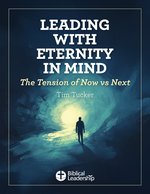How to keep worship from becoming monotonous
 iStock
iStock
Leading worship is something most church leaders delegate. Yet it is also something a church leader needs to understand and if required, give leadership to it.
One of the most confusing areas for church leaders who are not musicians is the importance of tempo. First, I will explain the basics of the song tempo. And then I will show the importance of evaluating it and giving leadership in an area where the church leader may not (yet) have expertise.
Leading through tempo
Having evaluated hundreds of churches, I find that in many plateaued or declining churches their worship leaders are choosing songs in the Lento/Largo tempo (40-60 beat per minute), which means "very slow." Even when worship leaders pick up the tempo, they usually do so only slightly, to an Adagio tempo (66-76 beats per minute) which is "slow and stately" or Andante(76-108 beats per minute) which is "at a walking pace."
There is nothing wrong with worship songs in these "slow and stately" tempos. But in the plateaued or declining church, a lack of higher-tempo songs creates a sense of "slogging" through a worship package.
Worship in the Scriptures at times clearly involves an up-tempo and celebratory spirit. For example, look at Psalm 150:1-6 in The Message:
Hallelujah!
Praise God in his holy house of worship,
praise him under the open skies;
Praise him for his acts of power,
praise him for his magnificent greatness;
Praise with a blast on the trumpet,
praise by strumming soft strings;
Praise him with castanets and dance,
praise him with banjo and flute;
Praise him with cymbals and a big bass drum,
praise him with fiddles and mandolin.
Let every living, breathing creature praise God!
Hallelujah!
Lead through variety
Tedium can result when a preacher also preaches in a "slow and stately" or "at a walking pace" tempo. In one client church, I witnessed how the entire service seemed laborious, forced and tiresome.
The preacher was a gifted and stately speaker. But coupled with a slow and stately worship package, the entire service seemed tiresome. Rather than the preacher's more sedate preaching style offering a respite from uptempo music, the worship package of only slow and stately music created a Sunday service with little variety, but much monotony.
Leaders with oversight of an entire Sunday service will want to encourage the worship leaders to intersperse Moderatoand above tempos (108+ beats per minute) into worship lists. This creates ebbs-and-flows during the worship package with both ...
- celebration and reflection
- excitement and calmness
- energy and stillness
- structure and flexibility
With these four steps a non-musical leader can evaluate worship (and lead improvements).
- Record each song and measure each bpm (beats per minute). Applications are available to measure this. Do this over a minimum of six weeks.
- Is there a variety? When do songs under 108 bpm occur? When do songs over 108 bpm occur?
- What needs to change? Are uptempo songs needed during the worship package to energize the worshippers?
- Along with worship leaders, find songs in the tempos needed to create variety and inspiration.
Here is a helpful chart of the most common tempo markings (with bpm) and definitions:
- Prestissimo (> 200 bpm) very very fast
- Presto (168 - 200 bpm) very fast
- Allegro (120 - 168 bpm) fast
- Moderato (108 - 120 bpm) moderately
- Andante (76 - 108 bpm) walking pace
- Adagio (66 - 76 bpm) slow and stately
- Lento/Largo (40 - 60 bpm) very slow
- Grave (20-40 bpm) slow and solemn
Remember, every leader may not be a musician. But every Christian leader is called to be a worshipper.
Bob Whitesel (D.Min., Ph.D.) is a foresight coach, professor, and award-winning author of 14 books. For over 30 years, he has guided leaders and churches to pivot and engage what’s next. He holds two earned doctorates from Fuller Theological Seminary and teaches on leadership foresight, church health, and organizational change. His website is www.ChurchForesight.com. Learn More » |
More on Church Leadership and Administration
- Responding to God’s activity in America (by Richard Blackaby)
- Video: A first step to an outward-focused church Is … (by Bob Whitesel)
- Taking church to where people already are (by Bob Whitesel)
- Eight essentials for guest-friendly church bulletins (by Thom Rainer)


